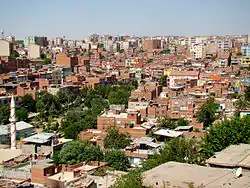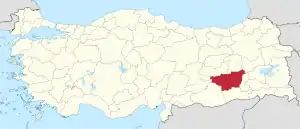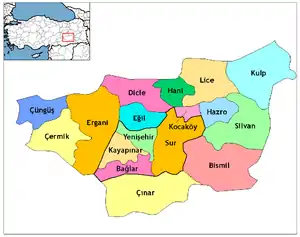Diyarbakır Province
Diyarbakır Province (Turkish: Diyarbakır ili, Zazaki:Suke Diyarbekır[2] Kurdish: Parêzgeha Amedê[3]), is a province in southeastern Turkey. The province covers an area of 15,355 km2 and its population is 1,528,958. The provincial capital is the city of Diyarbakır. The province has a Kurdish majority and is considered part of Turkish Kurdistan.[4][5]
Diyarbakır Province
Diyarbakır ili | |
|---|---|
 | |
 Location of Diyarbakır Province in Turkey | |
| Country | Turkey |
| Region | Southeast Anatolia |
| Subregion | Şanlıurfa |
| Government | |
| • Electoral district | Diyarbakır |
| • Governor | Münir Karaloğlu |
| Area | |
| • Total | 15,355 km2 (5,929 sq mi) |
| Population (2018)[1] | |
| • Total | 1,732,396 |
| • Density | 110/km2 (290/sq mi) |
| Area code(s) | 0412 |
| Vehicle registration | 21 |
History
It has been home to many civilisations and the surrounding area including itself is home to many Mesolithic era stone carvings and artifacts. The province has been ruled by the Akkadians, Hurrians, Mittani, Medes, Hittites, Armenians, Arameans, Neo-Babylonians, Achaemenids, Greeks, Romans, Parthia, Byzantium, Sassanids, Arabs, Seljuk Empire, Mongol Empire, Safavid dynasty, Marwanids, and Ayyubids.
In Turkey
In order to Turkify the local population,[6] in June 1927 the Law 1164 was passed[7] which allowed the creation of Inspectorates-General (Turkish: Umumi Müffetişlik, UM).[8] The Diyarbakır province was therefore included in the so-called First Inspectorate General (Turkish: Birinci Umumi Müffetişlik), which span over the provinces of Hakkâri, Siirt, Van, Mardin, Bitlis, Sanlıurfa, Elaziğ and Diyarbakır.[9]The first UM was created on the 1 January 1928 and centered in Diyarbakır.[10] The UM was governed by an Inspector General, who governed with a wide-ranging authority over civilian, juridical and military matters.[8] The office of the Inspector General was dissolved in 1952 during the government of the Democrat Party.[11] The Diyarbakır province though was still banned for foreign citizens until 1965.[9] Within the policy of turkification, during the 1930s, several place-names in the province were renamed into names which denoted a Turkish origin.[12]
Modern history
From 1987 to 2002, Diyarbakir Province was part of the OHAL (State of emergency) region which was declared to counter the Kurdistan Workers' Party (PKK) and governed by a so called Supergovernor who got invested with additional powers than a normal Governor. In 1987 he was given the power to relocate and resettle whole villages, settlements and hamlets.[13] In December 1990 with the Decree No. 430, the supergovernor and the provincial governors in the OHAL region received immunity against any legal prosecution in connections with actions they made due to the powers they received with the Decree No. 430.[14]
Archaeology
Archaeologists headed by the vice-rector of Dicle University, professor Ahmet Tanyıldız have claimed to discover the graves of the Seljuk Sultan of Rum Kilij Arslan I who defeated the Crusaders. They also revailed his daughter Saide Hatun's burial in Silvan. Researchers dug 2 meters deep across a 35-square-meter area and focused their works on two gravesites in Orta Çeşme Park.[15][16]
Districts
Diyarbakır province is divided into 14 districts:
Population
| Assyrian and Armenian population in Diyarbakır Province in 1915-1916[17] | |||||
| Sect | Before World War I | Disappeared (killed) | After World War I | ||
|---|---|---|---|---|---|
| Armenians | Gregorians (Apostolic) | 60,000 | 58,000 (97%) | 2,000 | |
| Armenian Catholics | 12,500 | 11,500 (92%) | 1,000 | ||
| Assyrians | Chaldean Catholics | 11,120 | 10,010 (90%) | 1,110 | |
| Syriac Catholic | 5,600 | 3,450 (62%) | 2,150 | ||
| Syriac Orthodox | 84,725 | 60,725 (72%) | 24,000 | ||
| Protestants | 725 | 500 (69%) | 2,150 | ||
References
- "Population of provinces by years - 2000-2018". Turkish Statistical Institute. Retrieved 9 March 2019.
- Zazaca -Türkçe Sözlük, R. Hayıg-B. Werner
- "Odeya Pizîşkên Amedê: 200 kes bi koronayê ketine". Rûpela nû (in Turkish). 8 April 2020. Retrieved 27 April 2020.
- Watts, Nicole F. (2010). Activists in Office: Kurdish Politics and Protest in Turkey (Studies in Modernity and National Identity). Seattle: University of Washington Press. p. 167. ISBN 978-0-295-99050-7.
- "Kurds, Kurdistān". Encyclopaedia of Islam (2 ed.). BRILL. 2002. ISBN 9789004161214.
- Üngör, Umut. "Young Turk social engineering : mass violence and the nation state in eastern Turkey, 1913- 1950" (PDF). University of Amsterdam. pp. 244–247. Retrieved 8 April 2020.
- Aydogan, Erdal. "Üçüncü Umumi Müfettişliği'nin Kurulması ve III. Umumî Müfettiş Tahsin Uzer'in Bazı Önemli Faaliyetleri". Retrieved 8 April 2020.
- Bayir, Derya (2016-04-22). Minorities and Nationalism in Turkish Law. Routledge. p. 139. ISBN 978-1-317-09579-8.
- Jongerden, Joost (2007-01-01). The Settlement Issue in Turkey and the Kurds: An Analysis of Spatical Policies, Modernity and War. BRILL. pp. 53. ISBN 978-90-04-15557-2.CS1 maint: date and year (link)
- Umut, Üngör. "Young Turk social engineering : mass violence and the nation state in eastern Turkey, 1913- 1950" (PDF). University of Amsterdam. p. 258. Retrieved 8 April 2020.
- Bozarslan, Hamit (2008-04-17). Fleet, Kate; Faroqhi, Suraiya; Kasaba, Reşat; Kunt, I. Metin (eds.). The Cambridge History of Turkey. Cambridge University Press. p. 343. ISBN 978-0-521-62096-3.
- Üngör, Uğur (2011), The Making of Modern Turkey: Nation and State in Eastern Anatolia, 1913–1950. Oxford: Oxford University Press, p. 244. ISBN 0-19-960360-X.
- Jongerden, Joost (2007). The Settlement Issue in Turkey and the Kurds. Brill. pp. 141-142. ISBN 978-90-47-42011-8.
- Norwegian Refugee Council/Global IDP Project (4 October 2002). "Profile of internal displacement: Turkey" (PDF). p. 78.
- Gershon, Livia. "Turkish Archaeologists Discover Grave of Sultan Who Defeated Crusaders". Smithsonian Magazine. Retrieved 2021-01-20.
- AA, DAILY SABAH WITH (2021-01-13). "Anatolian Seljuk Sultan Kılıç Arslan I's grave found in SE Turkey". Daily Sabah. Retrieved 2021-01-20.
- Gaunt, David. Massacres, Resistance, Protectors: Muslim-Christian Relations in Eastern Anatolia during World War I. Piscataway, N.J.: Gorgias Press, 2006, p. 433.
External links
- (in English) Pictures of the capital of this province
- (in English) Diyarbakir Weather Forecast Information
- (in English) Historical Armenian presence in Diyarbakir Province
- Tourism information is available in English at the Southeastern Anatolian Promotion Project site.
- (in English) Diyarbakir Live News

